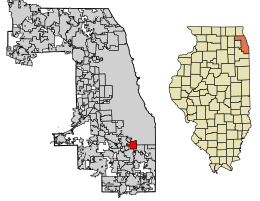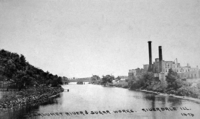Riverdale, Illinois
Riverdale is a village and a south suburb of Chicago in Cook County, Illinois, United States. The population was 13,549 at the 2010 census.[3] The village shares its name with the bordering Riverdale neighborhood in Chicago.
Riverdale, Illinois | |
|---|---|
Village | |
| Village of Riverdale | |
| Motto(s): "A Village with a Vision" | |
 Location of Riverdale in Cook County, Illinois. | |
.svg.png) Location of Illinois in the United States | |
| Coordinates: 41°38′26″N 87°37′50″W | |
| Country | |
| State | Illinois |
| County | Cook |
| Townships | Thornton, Calumet |
| Government | |
| • Mayor | Lawrence Jackson |
| Area | |
| • Total | 3.75 sq mi (9.71 km2) |
| • Land | 3.58 sq mi (9.26 km2) |
| • Water | 0.17 sq mi (0.45 km2) 4.80% |
| Population (2010) | |
| • Total | 13,549 |
| • Estimate (2019)[2] | 13,077 |
| • Density | 3,657.90/sq mi (1,412.20/km2) |
| Down 10.00% from 2000 | |
| Standard of living (2007-11) | |
| • Per capita income | $16,463 |
| • Median home value | $101,300 |
| ZIP code(s) | 60827 |
| Area code(s) | 708 |
| Geocode | 64278 |
| FIPS code | 17-64278 |
| Website | www |
| Demographics (2010)[3] | |||
|---|---|---|---|
| White | Black | Asian | |
| 4.3% | 93.7% | 0.1% | |
| Islander | Native | Other | Hispanic (any race) |
| 0.0% | 0.2% | 1.7% | 1.7% |
Geography


Riverdale is located at 41°38′26″N 87°37′50″W (41.640684, -87.630645).[10]
According to the 2010 census, Riverdale has a total area of 3.745 square miles (9.70 km2), of which 3.57 square miles (9.25 km2) (or 95.33%) is land and 0.175 square miles (0.45 km2) (or 4.67%) is water.[11]
Demographics
| Historical population | |||
|---|---|---|---|
| Census | Pop. | %± | |
| 1880 | 450 | — | |
| 1900 | 558 | — | |
| 1910 | 917 | 64.3% | |
| 1920 | 1,166 | 27.2% | |
| 1930 | 2,504 | 114.8% | |
| 1940 | 2,865 | 14.4% | |
| 1950 | 5,840 | 103.8% | |
| 1960 | 12,008 | 105.6% | |
| 1970 | 15,806 | 31.6% | |
| 1980 | 13,233 | −16.3% | |
| 1990 | 13,671 | 3.3% | |
| 2000 | 15,055 | 10.1% | |
| 2010 | 13,549 | −10.0% | |
| Est. 2019 | 13,077 | [2] | −3.5% |
| U.S. Decennial Census[12] | |||
As of the 2010 census, there were 13,549 people, 4,595 households, and 3,204 families residing in the village. The racial makeup of the village was 4.9% White, 94.0% African American, 0.5% Native American, 0.3% Asian, 0.1% Pacific Islander, 0.7% from other races, and 0.2% from two or more races. Hispanic or Latino of any race were 1.7% of the population.
There were 4,595 households, out of which 36.1% had children under the age of 18 living with them, 24.8% were married couples living together, 37.4% had a female householder with no husband present, 7.5% had a male householder with no wife present, and 30.3% were non-families. 25.7% of all households were made up of individuals, and 2.2% had someone living alone who was 65 years of age or older. The average household size was 2.92 and the average family size was 3.50.
In the village, the population was spread out, with 41.8% at the age 16 and over, 39.6% at the age 18 and over, 36.6% at the age 21 and over, 5.7% at the age of 62 and older, and 4.3% who were 65 years of age or older. The median age was 32.8 years. The female population was 7,521 and the male population was 6,028.
The median income for a household in the village was $37,792.
Government
Riverdale is divided between two congressional districts. Most of the city is in Illinois' 2nd congressional district; the area west of Ashland Avenue and the area southwest of 141st and Halsted Streets are in the 1st district. The local government of Riverdale consists of six elected trustees, one elected village clerk, and one elected mayor. On April 9, 2013 incumbent mayor Deyon Dean was defeated by Trustee and mayor Lawrence Jackson was sworn in on May 2, 2013
Police department
In the history of the Riverdale Police Department, one officer has been killed while on duty.
Notable people
- Judith (nee Sell) Roney (1961-), award winning poet, author, and professor of creative writing at University of Central Florida. Author of "According to the Gospel of Haunted Women."
- Jonathan Periam (1823-1911), noted horticulturalist and long-time editor of the magazine Prairie Farmer,[13] spent 20 years farming on land spanning the Calumet River at Halsted Street.[14]
- Marcheline Bertrand, actress; mother of actress Angelina Jolie; grew up in Riverdale
- Antwaan Randle El, wide receiver for the Washington Redskins, and Pittsburgh Steelers; Super Bowl champion (XL); born in Riverdale
- Charles Christian Hammer, classical guitarist [15]
- Marjorie Pebworth, Illinois politician; lived in Riverdale.[16]
- Betty Robinson, Olympic gold medalist in the 100 and 400 meter relays (1928 & 1936); born in Riverdale
- Steamboat Struss, pitcher for the Pittsburgh Pirates; born in Riverdale
- Joseph C. Szabo, 12th Administrator of the Federal Railroad Administration. He previously served as a Village Trustee and Village President of Riverdale.[17]
References
- "2019 U.S. Gazetteer Files". United States Census Bureau. Retrieved July 14, 2020.
- "Population and Housing Unit Estimates". United States Census Bureau. May 24, 2020. Retrieved May 27, 2020.
- "Riverdale, Illinois Population: Census 2010 and 2000 Interactive Map, Demographics, Statistics, Quick Facts". CensusViewer. Retrieved April 6, 2016.
- "Charles Pope, Sugar Refiner, Passes Away". The Chicago Daily Tribune: 9. March 26, 1922.
- "Some Success with Sugar Beets". The Louisiana Planter and Sugar Manufacturer. LIII (18): 283–284. October 31, 1914.
- Wilson, James (1905). U.S. Department of Agriculture – Report No. 80 – Progress of the Beet-Sugar Industry in The United States in 1904. New York: Government Printing Office. pp. 60–61.
- "New Refining Company ACQUIRES Pope Factory – Plant at Riverdale, Ill, Purchased by Midwest Refining Company from Charles Pope Heirs". Facts about Sugar – A weekly Journal of the Sugar Industry. XV (20): 391. November 11, 1922.
- "General Manager McKinney Tells About The Future Plans Of The Company". The (Riverdale) Pointer. XVII (8): 1. November 11, 1922.
- Brennan, J.H. , H.E. Dunn and C.M. Cosman (1961). HISTORY OF IRON AND STEELMAKING IN THE UNITED STATES - Publication in One Book of a Series of Historical Articles That Have Appeared in Journal of Metals, 1956-1961. New York: Metallurgical Society of AIME. p. 100.
- "US Gazetteer files: 2010, 2000, and 1990". United States Census Bureau. 2011-02-12. Retrieved 2011-04-23.
- "G001 - Geographic Identifiers - 2010 Census Summary File 1". United States Census Bureau. Archived from the original on 2020-02-13. Retrieved 2015-12-25.
- "Census of Population and Housing". Census.gov. Retrieved June 4, 2015.
- "JONATHAN PERIAM DIES AT 88: Pioneer Agriculturist Came to Chicago in 1838. SERVED IN THE CIVIL WAR. Then Became Editor of Farm Journal; Retired 13 Years Ago". The Chicago Daily Tribune: 4. December 10, 1911.
- Volp, Henry (1937). The first hundred years, 1835-1935: historical review of Blue Island, Illinois. Blue Island: Blue Island Publishing. pp. 80–83.
- Sir Charles' Biography - Sir Charles Hammer Retrieved 2017-02-19.
- 'Illinois Blue Book 1967-1968,' Biographical Sketch of Marjorie Pebworth, pg. 203
- Doneski, Ellen L., ed. (April 21, 2009). "Nominations to the Department of Transportation, The Department of Commerce, and the Executive Office of the President" (PDF). Hearing before the United States Senate Committee on Commerce, Science, and Transportation. Washington, D.C.: United States Government Publishing Office. pp. 20–26.
External links
| Wikimedia Commons has media related to Riverdale, Illinois. |